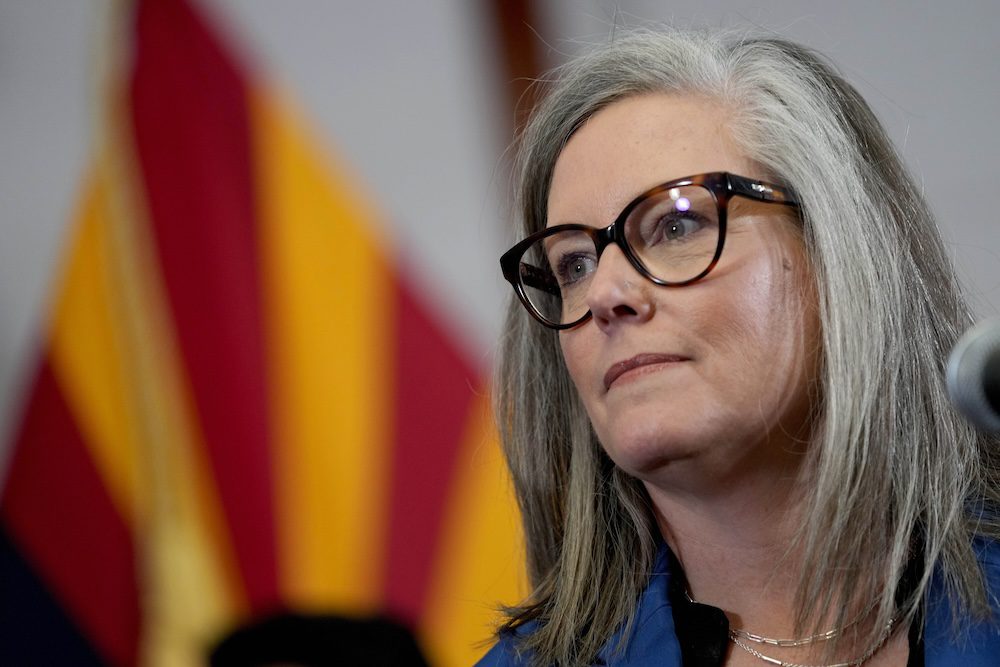
2 year old toddler Alice Harrolle rides her tricycle in her home on March 3rd, 2024. The Harrolle's used IVF and were later taxed with decisions on what to do with a surplus embryo created using the treatment. Photo by Andi Rice for The Washington Post via Getty Images.
Over 30,000 Arizonans receive reproductive and family planning healthcare every year thanks to a little-known government program with a painfully bureaucratic name.
This year, the local nonprofit that administers oversees that program, Affirm, turns 50. In an exclusive interview with The Copper Courier, Affirm CEO Bré Thomas sat down and outlined what Title X is, and how it helps Arizona families.
What is Affirm?
Affirm is a nonprofit organization that has been the primary recipient of Arizona’s Title X family planning grant since 1983. It then distributes these funds to varies agencies, clinics, and healthcare providers throughout the state that offer family planning and reproductive healthcare.
Affirm distributes funds to healthcare providers that qualify for and accept Title X as payment, similar to healthcare providers that accept Medicare of Medicaid. They currently work with approximately 50 providers in 11 of Arizona’s 15 counties.
“When somebody comes in, and they’re pregnant and they don’t know their options, they are provided information in a non-judgmental way,” said Thomas. “Here are your three options: You can have prenatal care, you can use adoption, or you can have an abortion. And it’s presented factually. We fund people to do this work.”
Title X was originally administered by county health departments—and still is in Pima and Pinal Counties—but over time, these departments divested from providing services. Affirm was founded to fill that gap, and now works with health departments to offer specialized services that they weren’t funded to address properly.
Since its founding, Affirm has helped hundreds of thousands of Arizonans navigate sexual health, reproductive care, and receive family planning counseling and guidance.
“We make sure that folks are able to get their services—again, confidentially, non-coercive, not shame-based, non-judgemental” said Thomas. “They have access to all FDA-approved contraception, they have access to all-options counseling. So it’s kind of like the gold star of contraception and sexual reproductive healthcare.”
So, what is Title X?
The ability for people to plan how they can comfortably build and grow their family was once a non-controversial issue. In 1970, President Richard Nixon signed into law the Family Planning Services and Population Act, which provided funding for contraceptives, cancer screening, STI testing and treatment, and other forms of reproductive healthcare.
The idea was to remove the barrier of cost associated with having and raising children. It also leaned on incorrect theories about population control and was seen at the time as an anti-poverty initiative. Thomas said that while some of the building blocks that brought about Title X are flawed, the foundation of helping families coupled with an understanding of bodily autonomy has provided millions of people a life that might not have been possible otherwise.
“We have grown and learned more since then,” said Thomas. “People are allowed to do what they want to do. They’re allowed to get pregnant, they’re allowed not to get pregnant, they’re allowed to end a pregnancy. So that whole bodily autonomy piece has come a little bit more robust in more recent years.”
What—and who—does it cover?
Title X offers income-based financial assistance for a number of reproductive healthcare offerings. Many who utilize the service have their care completely covered, while others use it to offset the prohibitively high cost of healthcare.
Title X can be used for:
- Pregnancy tests
- Pregnancy prevention, like birth control pills, condoms or intrauterine devices (IUD)
- Infertility care
- Treatment to increase the probability of getting pregnant
- Reproductive health counseling
- Cervical cancer screening
- Breast cancer screening
- HIV screening
- Sexually transmitted infection (STI) treatment
- Pelvic exams and pap smears
The requirements to qualify for Title X are very broad, and include anyone who can get—or cause—a pregnancy, meet income requirements, or are from a community that has historically been denied care. Minors do not need parental consent, and those with and without health insurance can use Title X.
Those interested in verifying eligibility and finding a health center can learn more here.
Shouldn’t Title X be managed by the state?
In addition to inadequately-funded health departments, Title X programs have been a subject of scorn among conservative lawmakers. Arizona’s health departments are led by political appointees, which can lead to decisions based more on ideology than medicine.
During the Trump administration, great efforts were taken to weaken Title X grants and make the program less effective. Part of that was requirements that state health departments adminster part of Title X grants, although they were not given an increase in funding to bring on administrative staff. They were also hamstrung by a Trump-era restriction on Title X funding for any facility that offered abortion services, limiting who they could refer patients to.
The results were disastrous. In 2018, Arizona Department of Health Services received 25% of Arizona’s Title X allotment—$900,000—and was only able to use $100,000.
“That’s the beauty of Affirm,” said Thomas. Rather than, maybe ADHS, who would politicize it under a different administration.”
Do people really use it?
On average, about 30,000 Arizonans benefit from Title X every year—although that number dropped to 12,000 while Trump was in office and US Congress was under Republican control.
More could benefit, said Thomas, but a major issue is funding. Republicans have blocked any additional Title X funding in the federal budget since 2014. If funding has kept up with inflation, Title X would have a budget of $672,012,450—more than double what it is currently allotted. In Arizona, that would increase funding from $6 million to over $8 million.
“We could use all $6.1 million in Maricopa County by itself and still not meet all the need,” Thomas said. “The need is so much more than what we are funded for.”
But don’t Republicans support family planning?
Republicans have fought against Title X for decades, despite its proven track record in lowering disease rates and preventing unwanted pregnancies. Research organization Guttmacher Institute found that, without Title X, there would have been an additional 387,000 unplanned births and 278,000 abortions in 2015 alone.
Their main opposition comes from the false belief that Title X covers the cost of abortions. It never has, although it does award grants to health centers that offer abortion-related healthcare, like Planned Parenthood.
But Thomas says she doesn’t buy the far-right fervor over abortions; to her, it’s much mroe simple than that.
“It’s control and power,” said Thomas. “They want to control and have power over women, and tell them to have more kids.”
In 2019, the Trump administration implemented a rule that prevented any healthcare center that offers abortion-related healthcare from receiving Title X funding. This severed Affirm’s ties with Planned Parenthood of Arizona, which provided care for 60% of all Title X patients at the time, resulting in the massive drop in Title X benefactors. That rule was reversed when President Joe Biden took office, but the fallout remains.
Will Title X be impacted by Prop 139
Arizonans will decide this November whether or not to make abortion care a protected right with Proposition 139, the Arizona for Abortion Access Act. The measure would remove government intervention from women’s healthcare and allow doctors to work with their patients to determin appropriate care.
While Title X does not cover abortion services, the turmoil seen by Arizona’s ever-changing abortion laws has created a cloud of confusion around reproductive care as a whole. Thomas said that once federal abortion protections were taken away in 2022, contraception, fertility care, and a number of health services were put in jeopardy.
“Because they’ve conflated family planning and abortion, they make it sound like it’s one thing. And people don’t understand because there’s not [proper] education, so the conflation confused people,” said Thomas. “The confusion obviously had a huge impact on people seeking abortion care, but it trickled down—and it really trickled down.”
Support Our Cause
Thank you for taking the time to read our work. Before you go, we hope you'll consider supporting our values-driven journalism, which has always strived to make clear what's really at stake for Arizonans and our future.
Since day one, our goal here at The Copper Courier has always been to empower people across the state with fact-based news and information. We believe that when people are armed with knowledge about what's happening in their local, state, and federal governments—including who is working on their behalf and who is actively trying to block efforts aimed at improving the daily lives of Arizona families—they will be inspired to become civically engaged.


This OB-GYN is concerned about Arizona’s rural maternity care deserts
NEED TO KNOW: 6 Arizona counties have fewer than 1 OB-GYN per 10,000 women. Of those, Greenlee County had no obstetric care providers in the entire...

Trump administration revokes guidance requiring hospitals to provide emergency abortions
WASHINGTON (AP) — The Trump administration announced on Tuesday that it would revoke guidance to the nation's hospitals that directed them to...

House GOP fast-tracks budget bill that would cut off Medicaid funding to Planned Parenthood
The budget package proposes steep health care cuts—and includes a new push to block patients from accessing reproductive care. In a 30-24 party-line...

Bill aimed at combating postpartum depression signed into law by Gov. Katie Hobbs
Making childbirth safer and making rural reproductive health care better are the goals of a new bill in Arizona, which Gov. Katie Hobbs signed into...





